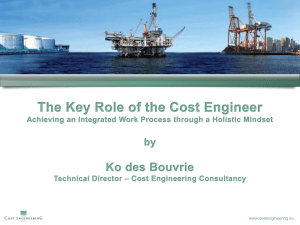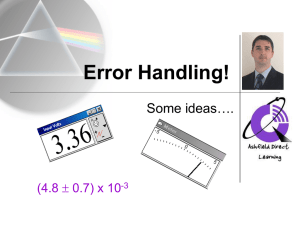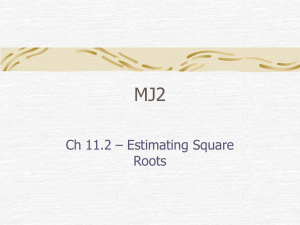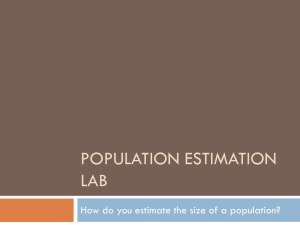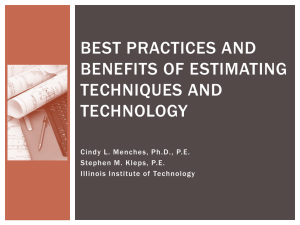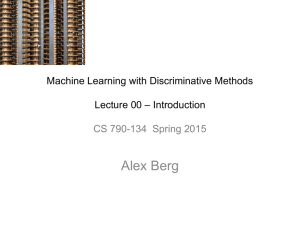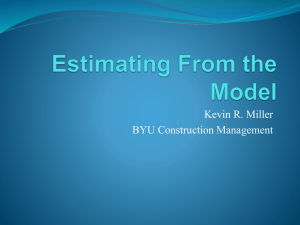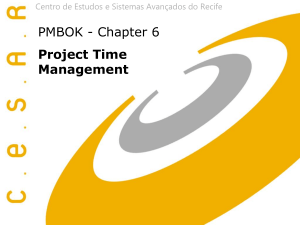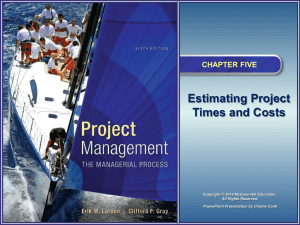Direct Estimation of Demand Curves
advertisement
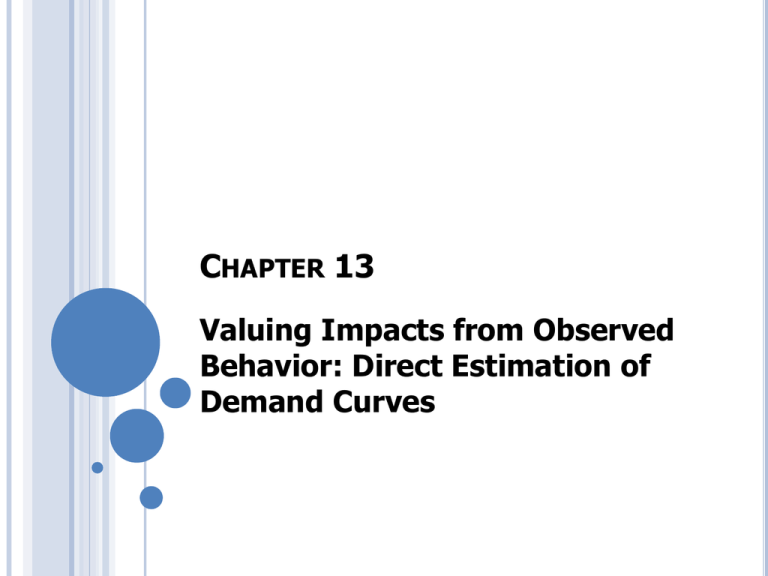
CHAPTER 13 Valuing Impacts from Observed Behavior: Direct Estimation of Demand Curves CHAPTER 13 ESTIMATING DEMAND Think of the chapter title… “Valuing behavior … by observing it…” How does observation occur? CHAPTER 13 ESTIMATING DEMAND Chapter objectives… Determine a demand function. Learn how to estimate demand. Understand statistical measures. CHAPTER 13 ESTIMATING DEMAND Interpret the results of statistical estimation of demand. Depict a demand curve. Determine social surplus. CHAPTER 13 ESTIMATING DEMAND “Measurement of changes in social surplus is relatively straightforward when we know the shapes (functional forms) and positions of supply and demand curves in the relevant market.” CHAPTER 13 ESTIMATING DEMAND Or, as Boardman, et al have stated, “to understand how a policy change will affect social surplus, we must know the shape and position of the supply and demand curves.” “In practice… these curves are not usually known.” CHAPTER 13 ESTIMATING DEMAND Or, as Boardman, et al have stated, “to understand how a policy change will affect ___________, we must know the shape and position of the supply and demand curves.” “In practice… these curves are not usually known.” CHAPTER 13 ESTIMATING DEMAND Or, as Boardman, et al have stated, “to understand how a policy change will affect _ social surplus_, we must know the shape and position of the supply and demand curves.” “In practice… these curves are not usually known.” CHAPTER 13 ESTIMATING DEMAND To begin to understand the measurement of demand, economists use the tools of regression analysis. CHAPTER 13 ESTIMATING DEMAND “Regression analysis is a technique used to determine the mathematical relations between a dependent variable and one or more explanatory variables.” Christopher Thomas and Charles Maurice, Managerial Economics, 10th Edition, McGraw-Hill, p. 121. CHAPTER 13 ESTIMATING DEMAND “Regression analysis is a technique used to determine the mathematical relations between a dependent variable and one or more ____________ variables.” Christopher Thomas and Charles Maurice, Managerial Economics, 10th Edition, McGraw-Hill, p. 121. CHAPTER 13 ESTIMATING DEMAND “Regression analysis is a technique used to determine the mathematical relations between a dependent variable and one or more __explanatory_ variables.” Christopher Thomas and Charles Maurice, Managerial Economics, 10th Edition, McGraw-Hill, p. 121. CHAPTER 13 ESTIMATING DEMAND “Explanatory variables are the economic variables that analysts believe affect the value of the dependent variable.” Christopher Thomas and Charles Maurice, Managerial Economics, 10th Edition, McGraw-Hill, p. 121. CHAPTER 13 ESTIMATING DEMAND Identify four or five explanatory variables: 1) “own price,” or “price” 2) 3) 4) 5) CHAPTER 13 ESTIMATING DEMAND Identify four or five explanatory variables: 1) “own price,” or “price,” 2) income, 3) 4) CHAPTER 13 ESTIMATING DEMAND Identify four or five explanatory variables: 1) “own price,” or “price,” 2) income, 3) population 4) CHAPTER 13 ESTIMATING DEMAND Identify four or five explanatory variables in Problem 2, p. 338: 1) price, 2) income, 3) population all. This problem has just three in CHAPTER 13 ESTIMATING DEMAND The analyst’s task… Collect enough information to estimate demand – and consumer surplus – using econometric techniques. CHAPTER 13 ESTIMATING DEMAND Reminder… Boardman et al … “we focus on estimating demand curves because, in practice, analysts are interested in estimating changes in social surplus …” Boardman, Greenberg, Vining and Weimer, CostBenefit Analysis, Prentice-Hall, 4th edition, p. 320. CHAPTER 13 ESTIMATING DEMAND Boardman, et al state that “the task in this chapter is to estimate changes in social surplus where there is limited information.” Boardman, Greenberg, Vining and Weimer, CostBenefit Analysis, Prentice-Hall, 4th edition, p. 320. CHAPTER 13 ESTIMATING DEMAND Think… social surplus demand information CHAPTER 13 ESTIMATING DEMAND In beginning the process of measuring demand, the analyst often faces three common situations… The analyst has only one observation … while some previous experience has led to an understanding of the demand curve’s slope or elasticity. CHAPTER 13 ESTIMATING DEMAND The analyst has several observations of price and quantity. CHAPTER 13 ESTIMATING DEMAND The analyst has many observations. CHAPTER 13 ESTIMATING DEMAND With many observations, the analyst may use econometric techniques to estimate the demand curve… and consumer surplus. And once consumer surplus is known, the analyst can observe how changes in the independent variables may affect this surplus. CHAPTER 13 ESTIMATING DEMAND Assignment… Prepare an econometric analysis of the demand for a publicly-funded swimming pool in Dryville, Texas. Determine demand. Measure consumer surplus. Define NSB of the project. CHAPTER 13 ESTIMATING DEMAND Information… Dryville has a population of 70,200 people and a median household income of $31,500. The analyst identified 24 towns in the region that already had public swimming pools. CHAPTER 13 ESTIMATING DEMAND Information… The analyst conducted a telephone interview with the recreation department in each town to find out what fee each charged per visit (FEE) and how many visits it had during the most recent summer season (VISITS). CHAPTER 13 ESTIMATING DEMAND In addition, the analyst was able to find each town’s population (POP) and median household income (INCOME) in the most recent census. CHAPTER 13 ESTIMATING DEMAND The assignment… Observe how changes in the independent variables may affect this surplus. This is an effort to observe demand. CHAPTER 13 ESTIMATING DEMAND The assignment… Observe how changes in the independent variables may affect this surplus. This is an effort to observe demand. CHAPTER 13 … DATA … CHAPTER 13 ESTIMATING DEMAND Question… How can the analyst use the foregoing data – information – to learn the dimensions of demand and the amount of well-being that constructing a pool will have for Dryville? CHAPTER 13 ESTIMATING DEMAND Response… Follow a few basic steps to complete the analysis of this problem. Then, present results… CHAPTER 13 ESTIMATING DEMAND As stated above, the analyst can use econometrics to estimate demand curves with many data observations. The starting point is to determine the independent variables, or the “determinants of demand”. The next step is to determine functional form. CHAPTER 13 ESTIMATING DEMAND Variable specification is used to isolate the independent effects of the variables of interest. q= f (p, I, T) Ordinary Least Squares regression is a useful estimation function for econometrics. CHAPTER 13 ESTIMATING DEMAND Cross-Sectional Data v. Time Series Data Cross-Section Data involves observations on a number of comparable units at the same point in time… CHAPTER 13 ESTIMATING DEMAND Cross-Sectional Data v. Time Series Data … Cross-sectional may be subject to heteroscedasticity problems. CHAPTER 13 ESTIMATING DEMAND Time Series Data… … involves making repeated observations on the same unit at several points in time. Time series data are prone to problems of autocorrelation. CHAPTER 13 ESTIMATING DEMAND Finally, the analyst subjects the data to statistical estimation… Discussion… STATISTICAL OUTPUT VISITS | Coef. Std. Err. t P>|t| [95% Conf. Interval] -------------+-----------------------------------------------------------------------------------------------------FEE -14638.37 2634.376 -5.557 0.000 -20133.58 -9143.158 INCOME -.0011269 .2053551 -0.005 0.996 -.4294902 .4272364 POP .6030525 .0524211 11.504 0.000 .4937039 .7124011 _ con 140546.7 7135.002 19.698 0.000 125663.4 155430.1 --------------------------------------------------------------------------------------------------------------------- DEMAND CURVE ESTIMATION VISITSs= 140,547 – 14,638*FEE – 0.001127*INCOME + .6031 *POP (demand for any neighborhood) Inserting Income = 31,500 and POP= 70,200, we get demand curve estimation for Dryville: VISITSdv= 182,849 – 14,638*FEE DEMAND CURVE FOR DRYVILLE FEE $12.49 0 182,849 Visits DETERMINING DEMAND To estimate social benefits of Dryville pool based on the previous demand curve, we must find the area under the demand curve from VISTISdv = 0 to VISITSdv = 182,849. Numerical Solution: .5*12.49*182,849 = $1,141,892 Graphical Solution: Fee 12.49 Social Benefit 0 Visits 182,849 The gross benefit = 966372+168211 = 1134583 VISITSdv = 182849 – 14638*FEE Fee (.5)(168211)(12.49-1) = 966372 $12.49 VISITSdv = 182849 - 14638*(12.49) = 0 VISITSdv = 182849 - 14638*(0) = 182849 If Fee= 1 VISITSdv = 182849 - 14638*(1) = 168211 Consumer Surplus Consumer $1 surplus Government Revenue 168211 182849 visits = (168211)(1) Additional benefit in the form of reduced excess burden of taxation = (0.25 * 168211) = 42053 Total gross benefit = 1134583 + 42053 = 1176636 CONCLUSIONS What are reasonable data sources? •Prior research One must consider validity problems: 1. Internal Validity • How valid is the estimate? • How was it measured and computed? 2. External Validity • Can the data be used in this instance? • How similar is the case in question to the research case? CONCLUSIONS What factors are important in estimating a demand curve? •Observations: more is better •Which variables you put into the model •Quality data sets •Interpretation and understanding of data Econometric analysis is very common and used to predict responses to changes in healthcare policy, infrastructure, and consumer prices. CONCLUSIONS What factors are important in estimating a demand curve? •Observations: more is better •Which variables you put into the model •Quality data sets •Interpretation and understanding of data Econometric analysis is very common and used to predict responses to changes in healthcare policy, infrastructure, and consumer prices. CHAPTER 13 ESTIMATING DEMAND Questions for Test 2 ……. 1. What are several basic “starting points” (some knowledge of demand is known) in the estimation of demand for a good or service? Describe these starting points and how you would proceed in the estimation of consumer surplus. 2. Identify at least three determinants of demand. 3. After these three, identify additional determinants in special circumstances (i.e. the demand function for residential electricity use most likely has a determinant that you would not have in the demand function for oranges). 4. What is the difference between a movement along a demand curve and a shift in the curve? CHAPTER 13 ESTIMATING DEMAND Questions for the Final Exam ……. 5. What is meant by specifying a demand relationship? 6. Discuss how you would go about collecting data for an estimation. 7. Discuss how you would estimate demand once you have collected the data that you believe that must be in the model. a. Include a discussion of the signs on the coefficients of the independent variables. 8. What is meant by the “standard error” on the coefficients of the independent variables in the model? 9. What is meant by price elasticity of demand, and how would you use the coefficient of price in an estimated model to identify the value of price elasticity? CHAPTER 13 ESTIMATING DEMAND Questions for the Final Exam ……. 10. What is the expected sign on the coefficient of price elasticity in the model? 11. What is the expected sign on the coefficient of income (for a normal good)? 12. What does the “R-square” tell the economist? End of Questions
